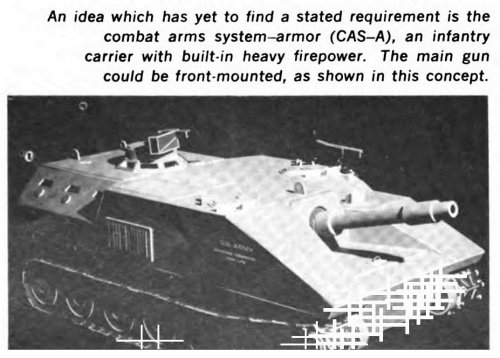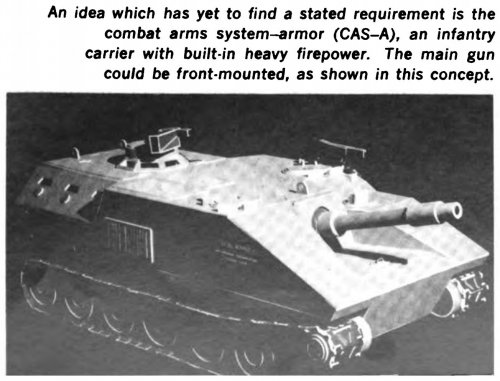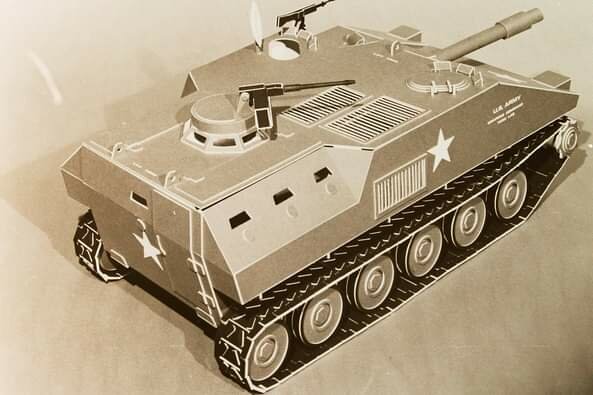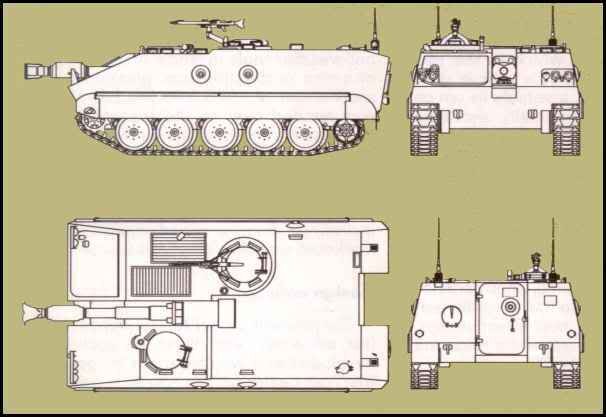- Joined
- 9 October 2009
- Messages
- 21,147
- Reaction score
- 12,249
Grey Havoc said:Charles Gray said:In the 1970's, I saw concepts for a MIAG (Mechanized infantry Assault Gun, AFAIK), that had a six man dismount team, with a vehicle that was armored to tank standards and had an external 105mm cannon. I wsa never able to find much more information on it then the picture and sadly lost that some years ago (so if anyone can help me there...), but the designed seemed very effective although It came out during the hysteria about the Russian introduction of Reactive armor where people were talking about the unstoppable red horde tanks laughing off TOWS on their march to France, so I'm not certain if there was any real work done on it or if it was a artist concept only.
Came across a ARMOR (Jan-Feb 1972) article on the MIAG yesterday. Pages 34 - 41 (PDF pages 36 - 43). Unfortunately Charles Gray hasn't been online since August 2011.
An excerpt:
The main armament of the MIAG is a 152mm
gun, identical to that carried by the XM803 (less
missile particular components). This gun was chosen
because of its extremely powerful round (both
authors have observed the devastating effect of the
HEAT-MP-T round on bunkers during operations
on the DMZ) and relatively short tube length, which
is a necessary concession to maneuverability in a
turretless vehicle. The missile system has been
dropped because it would add weight, take up valu-
able space, lower maintainability, and reduce the
number of rounds which could be carried in the
basic load. The number of basic load main gun
rounds becomes critical when viewed vis-a-vis the
weapon's offensive employment. The missile system
is primarily an antitank weapon, and the TOW
platoon already possesses that capability, rendering
the addition of the Shillelagh an expensive duplication
of effort.
The tube would elevate from +30 to -10 degrees,
but would, like all turretless vehicles, possess limited
traverse (& 10 degrees), bolder changes in azimuth
being accomplished by pivoting the vehicle. The
semifixed gun mount and hydraulic suspension of the
STRV103 have not been adopted. These characteristics
are useful for a weapon with an automatic
loader, but otherwise add weight, complexity, increase
maintainability headaches, and eliminate most
points of commonality with the MICV. We feel no
need to decrease the crew by adding an automatic
loader, in fact, a fifth crew member has been added.
Ammunition is the same as that proposed for the
XM803, HEAT-MP-T, WP, HVAP-DS-T, and cannister.
A time fuzed beehive round on the order of
that issued in Vietnam for the 90mm gun tanks
would be desirable but not essential.
The fire control system uses a laser rangefinder
combined with the same digital computer used in the
M60A1E2. A secondary system uses an articulated
telescope with stadia reticle. There is no stabilization,
as this vehicle would not wisely be fired on the
move. A combination 360 degree periscope and 10-
power binocular periscope (similar to a BC scope)
are provided to the commander for target acquisition.
A low light level sight is also installed.
The secondary armament system consists of two
M60 machine guns. One is placed at the commander’s
station and the other opposite him and slightly to
his rear at a position manned by a machine gunner,
whose sole task is to protect the vehicle from enemy
infantry. Both are provided with optical and
mechanical linkages which allow them to be aimed
and fired from inside the cupolas. No coaxial weapon
has been provided due to the slow and limited
traverse of the main gun.
In deciding on the necessary armor protection, it
was assumed that the vehicle, to have an acceptable
degree of survivability, must be protected in front
from automatic weapons fire up to 23mm. This
decision was based on the high density in Soviet
formations of weapons of this caliber. These, though
intended primarily for antiaircraft protection, would
inevitably be incorporated in the defense in an
armor-defeating role.
Note: Given the date and lack of dismounts among other things, I suspect that this was the early incarnation of the MIAG proposal.
EDIT: Ack, blundered on the title! I put down MIVC-70 instead of MICV-70 and only noticed it now!
Last edited:






